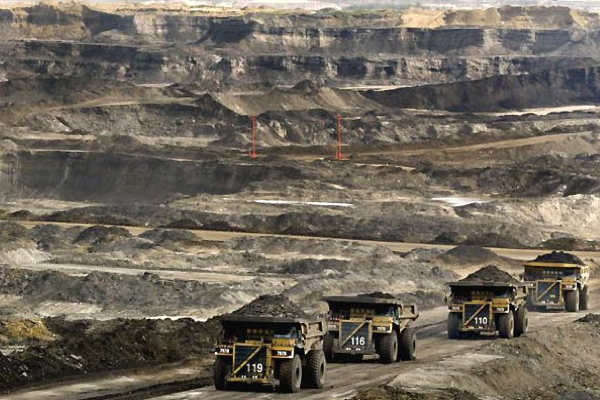Canadian oil sands set to benefit from low crude output

Mining at the Alberta oil sands. (Courtesy of Pembina Institute).
Canadian oil producers are set to benefit from a slowdown in crude output driven by a long-dragged slump in prices, as reduced drilling should free up pipeline space, data from the Canadian Energy Research Institute shows.
But while CERI predicts crude production from wells will slow this year to about 17,000 barrels a day in 2016, it also says oil sands activity is on a different trajectory.
“We have oil sands projects that are under construction and that you can’t stop them – they’re half or two-thirds completed,” CERI’s president emeritus Peter Howard told CBC News last week.
Alberta and other energy-producing regions have been feeling the impact of almost a year-long oil rout, despite signs of price recovery.
Unemployment in the province, for years among Canada’s lowest, is up now to 5.5%, still under the national rate of 6.8%, but a marked change from recent years.
Jobless claims in for the oil-rich province climbed up 29.4% in February – the second consecutive month with an increase of more than 20% and the largest jump since the 2009 recession, data from Statistics Canada shows.
Alberta faces a cash crunch of as much as $7 billion, and has announced plans to slash about 1,700 jobs in health care.
In the oil patch, cuts that started with contractors and crews on drilling rigs have spread fast to white-collar jobs in head offices as producers dig in for a prolonged slump.
Meanwhile, the combined spending of oil sands powerhouses Suncor Energy (TSE, NYSE:SU), Cenovus Energy (TSE, NYSE:CVE) and Canadian Natural Resources (TSE, NYSE:CNQ), is expected to drop to $26.9 billion this year, down 25%, or $8.9 billion, from $35.9 billion last year, according to data compiled by investment dealer Macquarie Group Ltd.
Despite the gloomy figures, the Canadian Energy Research Institute believes these and other producers can take advantage of the expected slowdown in crude production through spring and make use the space on the major trunklines, which should be positive for differentials this summer.
{{ commodity.name }}
{{ post.title }}
{{ post.date }}


Comments